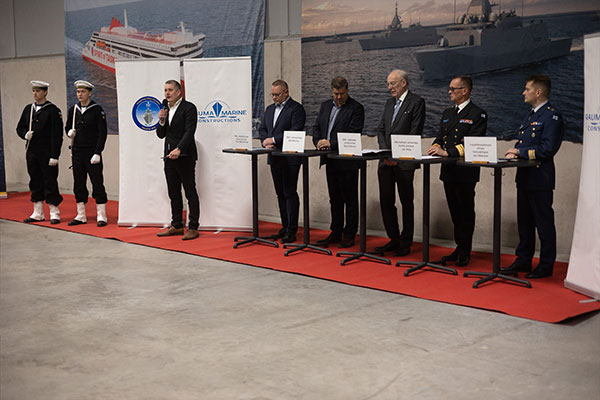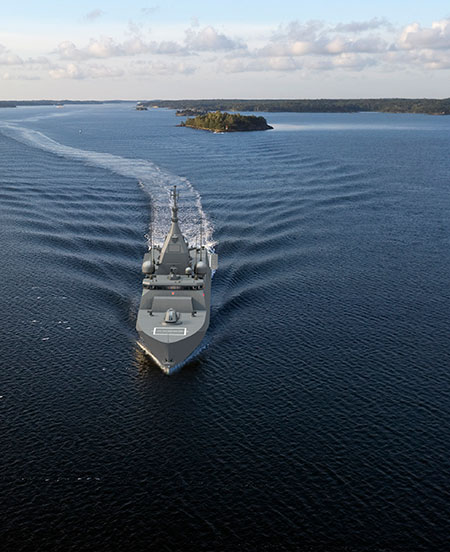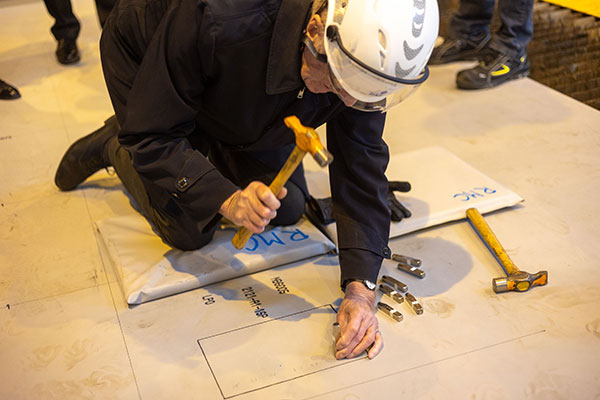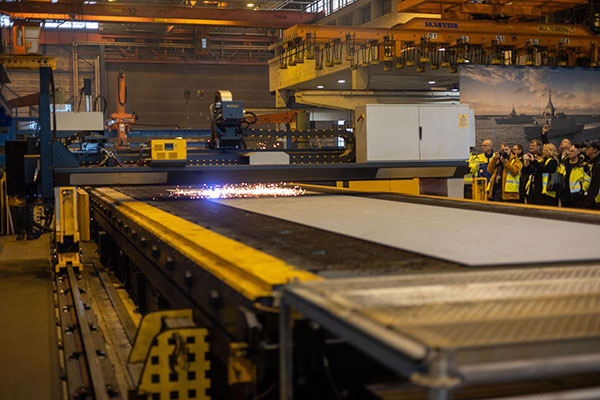Turnkey Deliveries
Yards
Finnish Navy’s multi-role corvettes under construction at Rauma shipyard

This Navy Squadron 2020 project will replace some of Finnish Navy’s current ships with new Pohjanmaa-class multi-role vessels, or corvettes. These multi-role vessels will have an essential
role in Finland’s future naval defence. The Finnish shipyard Rauma Marine Constructions (RMC) and its subsidiary RMC Defence will build the corvettes. Construction of the first vessel was
started in late October of 2023.
At RMC’s shipyard in Rauma on the
southwestern coast of Finland, the
steel cutting ceremony of the first Squadron
2020 multi-role corvette to be constructed
for the Finnish Navy was celebrated
on 30th October 2023.

The first corvette has been scheduled
for completion in 2026, with two more
vessels to follow in 2027 and the fourth in
2028. This major ship project ensuring the
Finnish national maritime defence capabilities
has been in preparation for several
years.
”The first spark for these multipurpose
vessels was lit up as early as 2007
when ideas for successors for the Finnish
Navy´s legacy vessels were being preliminarily
contemplated within the Navy. Later
on, further research on operational, tactical,
and technological levels was carried
out, to find out how new vessels should
actually operate and how their capabilities
could be utilised in various types of naval
operations,” explains Mr. Timo Ståhlhammar,
retired Navy Captain and currently
Project Director for Squadron 2020
at Rauma Marine Constructions (RMC).
”The Finnish Navy does not order
warships upon a spur-of-the-moment
inspiration. Procurement of vessels is based
on operational needs. In ship designs, possible
scenarios for battlefield operations
encountered on the current and, above all,
on the future battlefields – as well as the
required wartime capabilities of new vessels
– will be taken into account.”

RELIABLE OPERATION IN
VARIOUS ENVIRONMENTS
Finnish Navy’s new Pohjanmaa-class vessels
will monitor the Finnish sea area,
repel attacks from the sea, protect the
vital sea infrastructure of communication
and safeguard vital assets at sea and in
the archipelago. This will ensure that the
Navy will be able to conduct its statutory
defence tasks well into the future and control the sea and archipelago areas having
significance from the perspective of operations.
The high-performance vessels are
designed to operate in the Baltic Sea all
year round in various circumstances, ranging
from autumn storms to icy and freezing
conditions.
”These four vessels are rather exceptional,
with their versatile capabilities optimised
for this northern operating environment,”
Mr. Ståhlhammar notes.
”In September 2019, the contract
between Finnish Defence Forces Logistics
Command and RMC Defence was signed.
This started the project for the eventual
design and production of four new multipurpose
corvettes.”
The multi-role corvettes will have a
length of 117 metres, a width of 16 metres and a speed of 26 knots (48 km/h), with
accommodation for a crew of 70 persons.
The four new ships will in time
replace seven older vessels: the four
Rauma-class fast-attack missile craft and
two Hämeenmaa-class mine-laying ships,
as well as one Pohjanmaa-class minelayer
that was already decommissioned in 2013.

FUNCTIONAL, DISCREET,
AND ROBUST
According to Mr. Ståhlhammar, the preliminary
planning was based on the customer’s
concept. The ship designs were
then further developed in close cooperation
between RMC shipyard and the Finnish
Defence Forces.
”Consequently, the final blueprints
depict a fully functioning ship model, from
all points of view.”
The new Pohjanmaa-class corvettes
will be equipped with top-notch monitoring
capacities for air, surface and underwater
surveillance. They must also be capable
of laying mines, defending themselves
against hostile surface vessels as well as
submarines and various airborne targets,
and command maritime operations. Such
vessels can be used in crisis management
measures and as part of NATO’s Standing
Naval Forces.
“The design of the corvettes pays
particular attention to shock resistance,
noise levels and stealth technology. The
multi-role corvettes are the first vessel
class in the Finnish Navy designed and
constructed under the surveillance of the
ship classification society, including the
ship’s performance in ice,” Ståhlhammar
points out.
”The corvettes have been designed
to navigate unaided even in relatively thick
ice. This is practical as it enables the vessels
to proceed from the Naval Base to open sea
without ice-breaker assistance throughout
the winter season.”

DESIGNED FOR LONG-TERM
DURABILITY
The Finnish maritime defence has for a
long time relied on shipbuilding expertise
from Rauma, as most vessels that the
Finnish Navy has adopted since 1990 have
been built at Rauma. Furthermore, a significant
number of vessels owned by the Finnish
State, including all multipurpose icebreakers
and Finnish Boarder Guard patrol
boats, have been built, maintained, and
repaired at Rauma shipyard.
”The new multipurpose corvettes are
being built in Finland mainly for two reasons.
One is to ensure that the domestic defence industries retain the capability
to construct such vessels even in the
foreseeable future. Also, it is crucial that
the vessels can be repaired, maintained,
and upgraded in Finland,” Ståhlhammar
emphasises.
The corvettes are being constructed
in a new multipurpose workshop that has
been built specifically for this project. The
workshop will provide suitable conditions
for the production and will enhance security
and quality. RMC’s new steel production process will allow for the welding of
even thinner plates. Still, the hull has been
specified to withstand a reasonable impact
of underwater explosive force. Such shockabsorption
propensities are not uncommon
in warship designs.
Furthermore, RMC has constructed
a reference block to ensure the technical
production capacity of the project.
”The reference block enabled inter
alia testing and functionality of new facility
investments, including one-side plasma welding, modernisation of profile-cutting
machine, T-beam line, dimensional control
process, plus welding with surface treatment
and outfitting installations.”
”The product development of the
technically challenging corvettes will continue
even after the start of production,”
mentions Ståhlhammar.
By: Ari Mononen
Photos: Rauma Marine Constructions



